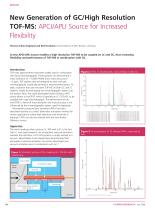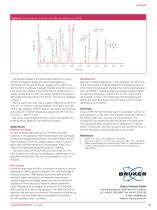
Catalog excerpts

New Generation of GC/High Resolution TOF-MS: APCI/APLI Source for Increased Flexibility Thomas Arthen-Engeland and Ralf Dunsbach, Bruker Daltonik GmbH, Bremen, Germany. A new APCI/APLI source enables a high resolution TOF-MS to be coupled on LC and GC, thus increasing flexibility and performance of TOF-MS in combination with GC. TOF mass spectrometers have been widely used in combination with liquid chromatography. These systems can demonstrate a mass resolution of Ͼ15000 FWHM and a mass accuracy of Ͻ2 ppm. TOF systems that are designed to work with gas chromatography usually demonstrate a reduced performance. To date, a solution that uses the same TOF-MS on both GC and LC systems, merely by exchanging the chromatographic system, has not existed. Now, the newly developed Bruker Daltonics APCI source allows a micrOTOF, which is basically an LC–TOF-MS, to be coupled with a gas chromatograph. The performance of the micrOTOF, in terms of mass resolution and mass accuracy, is not influenced by the chromatographic system used for separation. Atmospheric pressure laser ionization (APLI) has been described recently as a useful alternative ionization method for certain applications where high selectivity and sensitivity is required.1 APLI can also be realized with the new Bruker Daltonics source. Figure 2: hrEIC of 28 pesticides, mass window: 0.002 Da. 1.2 1.0 GC–APCI 08 Pestizid Mix 40 g pro L in CH2CL2.d: EIC 216 ϩAll MS GC–APCI 08 Pestizid Mix 40 g pro L in CH2CL2.d: EIC 214 ϩAll MS GC–APCI 08 Pestizid Mix 40 g pro L in CH2CL2.d: EIC 172 ϩAll MS GC–APCI 08 Pestizid Mix 40 g pro L in CH CL .d: EIC 188 ϩAll MS GC–APCI 08 Pestizid Mix 40 g pro L in CH2CL2.d: EIC 174 ϩAll MS GC–APCI 08 Pestizid Mix 40 g pro L in CH CL .d: EIC 165 ϩAll MS GC–APCI 08 Pestizid Mix 40 g pro L in CH CL .d: EIC 249 ϩAll MS GC–APCI 08 Pestizid Mix 40 g pro L in CH CL .d: EIC 222 ϩAll MS GC–APCI 08 Pestizid Mix 40 g pro L in CH CL .d: EIC 284 ϩAll MS GC–APCI 08 Pestizid Mix 40 g pro L in CH CL .d: EIC 242 ϩAll MS GC–APCI 08 Pestizid Mix 40 g pro L in CH CL .d: EIC 180 ϩAll MS GC–APCI 08 Pestizid Mix 40 g pro L in CH CL .d: EIC 203 ϩAll MS GC–APCI 08 Pestizid Mix 40 g pro L in CH CL .d: EIC 291 ϩAll MS GC–APCI 08 Pestizid Mix 40 g pro L in CH2CL2.d: EIC 213 ϩAll MS GC–APCI 08 Pestizid Mix 40 g pro L in CH CL .d: EIC 241 ϩAll MS GC–APCI 08 Pestizid Mix 40 g pro L in CH2CL2.d: EIC 146 ϩAll MS GC–APCI 08 Pestizid Mix 40 g pro L in CH CL .d: EIC 233 ϩAll MS GC–APCI 08 Pestizid Mix 40 g pro L in CH2CL2.d: EIC 207 ϩAll MS GC–APCI 08 Pestizid Mix 40 g pro L in CH CL .d: EIC 278 ϩAll MS GC–APCI 08 Pestizid Mix 40 g pro L in CH CL .d: EIC 259 ϩAll MS GC–APCI 08 Pestizid Mix 40 g pro L in CH CL .d: EIC 215 ϩAll MS GC–APCI 08 Pestizid Mix 40 g pro L in CH CL .d: EIC 230 ϩAll MS GC–APCI 08 Pestizid Mix 40 g pro L in CH CL .d: EIC 202 ϩAll MS Apparatus The main handicap when using an LC–MS with a GC is the fact that LC mass spectrometers use atmospheric pressure ionization whereas the ionization in GC–MS systems is usually realized in a vacuum. Nevertheless it has already been demonstrated that atmospheric pressure ionization has certain advantages over vacuum ionization even in combination with GC.2 Figure 3: Chromatogram of 32 alkylated PAH, measured by APLI. 4 Figure 1: Schematic picture of the coupling GC–TOF-MS with transfer line. Intensity ϫ10 6 Corona needle GC-separation capillary AP ion source Glass tube Stainless steel capillary, resistively heated to 320 ЊC APLI27Febr000001.d: BPC49.009–500.994 ϩAll MS. –Spectral Bkgrnd
Open the catalog to page 1
Figure 4: Chromatogram of mouse urine after derivatisation by MSFTA. The solution realized in the new Bruker Daltonics ion source consists of a heated transfer line where the analytes are transferred from the end of the GC capillary and an API source into the MS. It is especially important that the end of the column is close to the inlet capillary of the MS to prevent condensation of sample components. For APCI the corona needle is mounted at a right angle to the gas stream from the GC. The set-up is displayed in Figure 1. The GC used in this work was an Agilent 7890 with an HP-5 ms, 0.25...
Open the catalog to page 2All Bruker Daltonics catalogs and technical brochures
-
Maritime Detection Systems
7 Pages
-
SVGps
4 Pages
-
RAPIDplus
7 Pages
-
TIMON
13 Pages
-
RoadRunner
5 Pages
-
MATRIX-MG Series
7 Pages
-
MALDI Biotyper® CA System
12 Pages
-
RAID-XP
5 Pages
-
RAID-M Series
7 Pages
-
HDX Solution
2 Pages
-
EVOQ GC-TQ
8 Pages
-
timsTOF PRO
8 Pages
-
Agri Solutions brochure
8 Pages
-
PesticideScreener
8 Pages
-
Elute LC series
8 Pages
-
nanoElute®
6 Pages
-
timsTOF™
8 Pages
-
rapifleX™
8 Pages
-
amaZon SL
6 Pages
-
compact
8 Pages
-
MALDI Biotyper
56 Pages
-
rapifleX™ MALDI Tissuetyper™
8 Pages
-
MALDI PharmaPulse™
4 Pages
-
Toxtyper
6 Pages
-
impact II
12 Pages
-
maxis II
12 Pages
-
amaZon speed
10 Pages
-
Albira Brochure
12 Pages
-
prime
12 Pages
-
solarix
10 Pages
-
Metabolomics
12 Pages
-
aurora M90
10 Pages
-
Clean Room Pack
4 Pages
-
MATRIX-F FT-NIR Spectrometer
2 Pages
-
TANGO
12 Pages
-
The new autoflex? series
10 Pages
-
MM 2
6 Pages
-
µRAID
4 Pages
-
Radiation Backpack Sentry
4 Pages
-
Posterbook Metabolomics ebook
14 Pages
-
CaptiveSpray nanoBooster
8 Pages
-
Scion SQ Series GC-MS
8 Pages
-
solariX XR
12 Pages
-
aurora Elite
6 Pages
-
nano-Advance UHPLC
8 Pages
-
EVOQ
12 Pages
-
CaptiveSpray
4 Pages
-
ImagePrep
4 Pages
-
micrOTOF-Q II
12 Pages
-
PROTEINEER fc II
4 Pages
-
Ultraflextreme
16 Pages
-
Autoflix speed
10 Pages
-
microflex
6 Pages
-
SCION 436-GC
4 Pages
-
SCION 456-GC
4 Pages
-
GC CARE
8 Pages
-
Brochure BioTools 2.2
10 Pages
-
Brochure micrOTOF II
8 Pages
-
Brochure EASY-nLC
6 Pages
Archived catalogs
-
impact HD
12 Pages
-
RAID-M 100
6 Pages
-
compact?
6 Pages
-
micrOTOF-Q III
6 Pages
-
Toxtyper
8 Pages
-
MALDI Biotyper
12 Pages
-
Brochure MetaboliteTools 1.1
8 Pages
-
Brochure ProfileAnalysis
4 Pages















































































